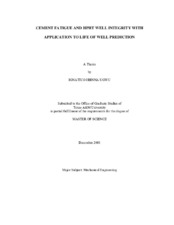| dc.description.abstract | In order to keep up with the world’s energy demands, oil and gas producing companies have taken the initiative to explore offshore reserves or drill deeper into previously existing wells. The consequence of this, however, has to deal with the high temperatures and pressures encountered at increasing depths.
For an oil well to maintain its integrity and be produced effectively and economically, it is pertinent that a complete zonal isolation is achieved during well completion. This complete zonal isolation can be compromised due to factors that come into play when oil well cement experiences cyclic loading conditions which can lead to fatigue failure as a consequence of extensive degradation of the microstructure of the cement material depending on stress levels and number of cycles. There have been a lot of research and experimental investigations on the mechanism of fatigue failure of concrete structures but the fatigue behavior of oil well cement is still relatively unknown to engineers. Research in the area of oil well cement design has led to improved cement designs and cementing practices but yet many cement integrity problems persist and this further strengthens the need to understand the mechanism of cement fatigue.
This research seeks to develop a better understanding of the performance of the casing cement bond under HPHT well conditions that can lead to best practices and a model to predict well life. An analytical model, which can be used to evaluate stresses in the cement sheath based on actual wellbore parameters, was developed and combined effectively with finite element models to evaluate the fatigue and static loading behavior of a well.
Based on the findings of this investigation, the mechanical properties of the casing, cement and formation as well loading conditions play a very big role in the static and fatigue failure of well cement.
Finally, recommendations for future work on this subject were also presented in order to understand all tenets of cement fatigue and to develop governing equations. | en |


